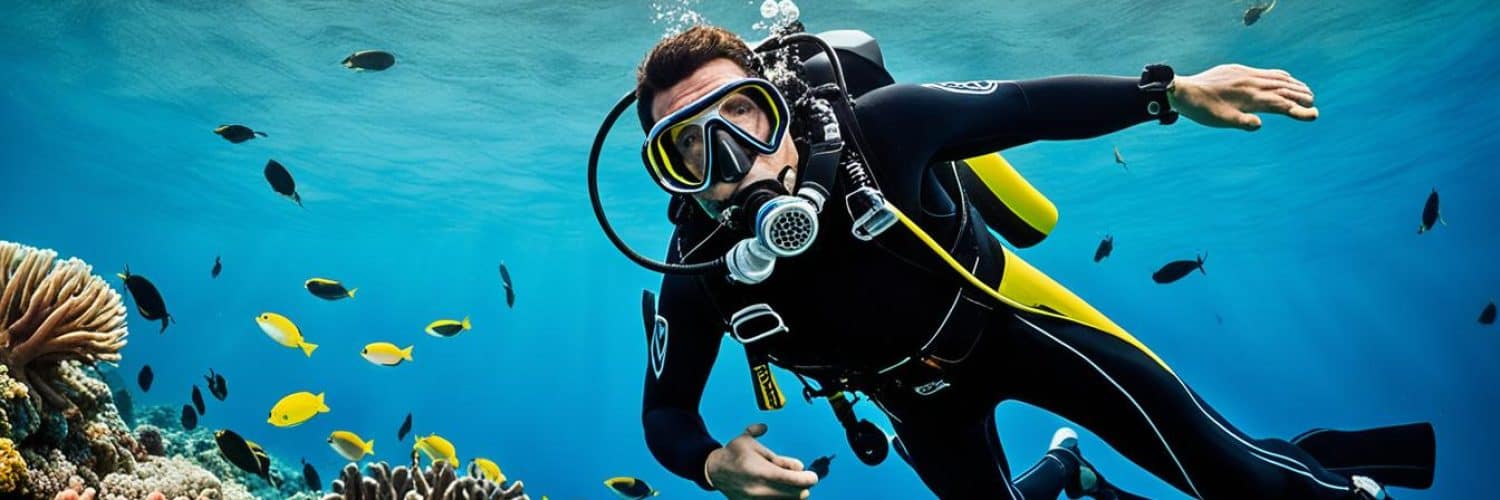When it comes to scuba diving, having the right equipment is crucial for a safe and enjoyable underwater experience. One essential piece of gear that every diving enthusiast needs is a reliable pair of scuba flippers. Also known as scuba diving flippers or scuba gear flippers, these fins play a vital role in propelling divers through the water and ensuring efficient movement.
Choosing the right scuba flippers can be overwhelming with so many options available on the market. From foot vs. open heel design to buckles vs. straps and blade styles, there are several factors to consider. However, understanding these key features will help you make an informed decision and find the perfect pair of scuba flippers that suit your diving style and preferences.
Key Takeaways:
- When choosing scuba flippers, consider factors such as foot vs. open heel design, buckles vs. straps, and blade style.
- Full foot fins are great for dive travel, while open heel fins work with a range of foot sizes but require booties.
- Buckles allow for fin tension adjustment, while quick-release buckles or spring kit systems offer a comfortable and secure fit.
- Blade styles vary, each offering different propulsion and swimming techniques.
- Trying out different types of fins and ensuring a secure fit is recommended before making a purchase.
Foot vs. Open Heel Design
When it comes to choosing scuba flippers, one important factor to consider is the design – specifically, whether to opt for full foot fins or open heel fins. Both designs have their advantages and are suited for different diving scenarios.
Full foot fins are designed to fit like a shoe and are ideal for dive travel. These fins are lighter in weight and do not require the use of booties. They provide a snug and comfortable fit, allowing for ease of movement in the water. Full foot fins are particularly popular among divers who prioritize convenience and prefer a minimalist approach to their scuba gear.
Open heel fins have a strap-like mechanism to secure the fins to your feet. They accommodate a range of foot sizes and are a preferred choice for divers who require a more customized fit. Open heel fins, however, do require the use of booties to be worn with them. This design is beneficial for shore diving, as it allows divers to easily walk out of the water with booties on. Additionally, open heel fins offer increased comfort during extended periods in the water.
Open heel fins are a popular choice for divers seeking versatility and a secure fit, while full foot fins are favored for their lightweight nature convenient for dive travel.
Comparing Foot vs. Open Heel Design
| Foot Fins | Open Heel Fins |
|---|---|
| Fit like a shoe | Accommodate a range of foot sizes |
| Lightweight | Require booties to be worn |
| Ideal for dive travel | Great for shore diving |
| No additional accessories required | Allow for easy walking out of water with booties |
By understanding the characteristics and benefits of both foot fins and open heel fins, you can make an informed decision based on your personal preferences and the specific diving conditions you’ll encounter.
Buckles vs. Straps
When it comes to open heel diving fins, there are different methods for attaching them to your feet. One of the most common attachment options is using basic buckles. These buckles allow you to adjust the tension of the fins, ensuring a secure fit. However, over time, these buckles may start to loosen, requiring periodic readjustments during your dive.
Alternatively, some buckles come with a quick release feature, allowing for easy adjustments even while in the water. This can be particularly convenient if you need to make quick changes to the fit or if you prefer the versatility of on-the-go adjustments.
A popular alternative to traditional buckles and straps is the use of spring kit systems. These systems replace the original buckles and straps with a more advanced design that provides a secure and comfortable fit for the entire duration of your dive. The spring kit ensures that the fins stay firmly in place without any risk of loosening or shifting underwater, allowing you to focus on your dive without any distractions.
Comparison Table: Buckles vs. Straps
| Buckles | Straps |
|---|---|
| Require periodic readjustments | Secure fit throughout the dive |
| Allows for tension adjustment | No need for tension adjustment |
| May loosen over time | Stay firmly in place |
| Quick release option available | No quick release option |
Overall, choosing between buckles and straps for your open heel diving fins depends on your personal preference and the level of convenience you desire. Basic buckles offer flexibility in adjusting the tension but require periodic readjustments. On the other hand, spring kit systems provide a secure and comfortable fit without the hassle of constant adjustments. Consider your diving style, comfort, and preference when making a decision.
Blade Style
When it comes to scuba flippers, the blade style is a crucial factor to consider. Different blade styles offer unique advantages and adaptability to various diving conditions. Let’s explore some popular blade styles and their features:
Standard Paddle Fins
The standard paddle fin design features a flat surface with reinforced sides, providing strength and stability. These fins are widely used and offer a good balance between power and ease of use. They are suitable for divers of all levels and are versatile for different diving environments.
Channel or Jet Fins
Channel or jet fins are the preferred choice among professional and technical divers. These fins are designed to efficiently contain and release water during your kick, maximizing propulsion. With their excellent control and power, channel fins allow divers to maneuver easily, making them ideal for challenging diving conditions.
Split Fins
Inspired by the efficient swimming motion of fish fins, split fins are designed to provide better propulsion with less effort. The split blade design allows water to pass through the fins, reducing drag. These fins are great for divers looking for a more relaxed and energy-efficient kick, making them a popular choice for recreational divers.
Force Fins
Resembling the shape of a whale tail, force fins are known for their lightness and efficiency. With a unique design that minimizes drag, they provide optimal performance and maneuverability underwater. Force fins are often favored by experienced divers who require precise control and less leg fatigue during long dives.
Hinged Fins
Hinged fins feature an adjustable angle, allowing divers to customize their fin position for different diving activities. These fins are particularly useful for shore diving, where divers may need to navigate through challenging entry and exit points. The hinged design provides flexibility and adaptability, enhancing comfort and efficiency in varying conditions.
Choosing the right blade style ultimately depends on your personal preferences, diving experience, and the specific conditions you will encounter. Experimenting with different blade styles can help you find the perfect match for your diving needs.
Choosing the Right Scuba Fins for You
Choosing the right scuba fins is a crucial decision that can greatly impact your diving experience. It is important to consider several factors, including your swimming style, diving location, and personal comfort.
Swimming Style: Different swimmers have varying preferences when it comes to fins. Some divers prefer fins that provide more power and propulsion, while others value agility and ease of movement. Understanding your swimming style will help you choose fins that complement your technique and enhance your performance underwater.
Diving Location: The environment in which you will be diving plays a significant role in determining the type of fins you should choose. For diving in calm, warm waters, lighter fins with shorter blades may be more suitable. On the other hand, if you plan to dive in strong currents or colder waters, fins with longer blades and enhanced propulsion capabilities may be necessary.
Personal Comfort: Comfort is paramount when it comes to scuba fins. Ill-fitting or uncomfortable fins can cause discomfort and affect your overall enjoyment of the dive. It is advisable to try out different types of fins before making a purchase. Renting or borrowing fins to test them in the water can give you a better understanding of their fit and comfort level. Additionally, trying on new fins before getting into the water is essential to ensure a secure fit and maximum comfort during your dive.
By considering your swimming style, diving location, and personal comfort, you can make an informed decision when choosing the right scuba fins for you. The right fins will provide you with the necessary propulsion, maneuverability, and comfort, allowing you to fully enjoy your underwater adventures.
“Choosing the right scuba fins can greatly enhance your diving experience. By considering factors such as swimming style, diving location, and personal comfort, you can find the perfect fins that suit your needs.”
Comparison of Scuba Fins
| Fins | Features | Pros | Cons |
|---|---|---|---|
| Brand A | – Open heel design – Quick-release buckles – Channel blade style |
– Excellent propulsion – Easy to adjust – Efficient water channeling |
– May require additional booties – Heavier than some other options |
| Brand B | – Full foot design – Spring kit system – Split blade style |
– Lightweight and travel-friendly – Secure and comfortable fit – Effortless swimming |
– Limited versatility for different foot sizes – Less efficient in strong currents |
| Brand C | – Open heel design – Quick-release buckles – Paddle blade style |
– Durable and long-lasting – Easy to adjust – Suitable for various diving conditions |
– Limited flexibility – Requires booties for optimal performance |
Tips for Choosing Scuba Fins:
- Try different types of fins before making a purchase
- Rent or borrow fins to test them in the water
- Ensure a secure and comfortable fit by trying new fins on before diving
- Consider your swimming style, diving location, and personal comfort
- Invest in well-fitting fins to avoid discomfort during dives
By following these tips and considering the various factors involved, you can confidently choose the right scuba fins for your diving needs. Remember, comfort and functionality are key when it comes to underwater exploration.
The Best Scuba Diving Fins
When it comes to the best scuba diving fins, two highly recommended options are the Scubapro Jet Fins with Spring and the Dive Rite XT Fins. These fins offer exceptional performance and durability, making them popular choices among scuba diving enthusiasts.
Scubapro Jet Fins with Spring
The Scubapro Jet Fins with Spring are designed for maximum propulsion and sturdiness, making them ideal for challenging conditions and strong currents. These fins feature an open heel design, which provides a secure fit and enables divers to easily adjust the strap tension. The spring straps offer added comfort and convenience, ensuring a snug fit that won’t loosen during the dive. With their exceptional power and control, the Scubapro Jet Fins with Spring are a reliable choice for divers who require top-notch performance.
Dive Rite XT Fins
The Dive Rite XT Fins are known for their combination of rigidity and flexibility, making them perfect for technical divers who need precise control without compromising power. These fins are designed with a blade that provides excellent thrust and maneuverability, allowing divers to navigate through different underwater environments effortlessly. The open heel design ensures a comfortable fit, and the adjustable strap allows for easy customization. With their superior design and performance, the Dive Rite XT Fins are a favorite among experienced divers.
Choosing the right scuba diving fins is crucial for a safe and enjoyable underwater experience. Whether you opt for the Scubapro Jet Fins with Spring or the Dive Rite XT Fins, both options offer exceptional quality and performance that will enhance your diving adventures.
Tips for Choosing Scuba Fins
When it comes to scuba diving, having the right equipment is crucial for a safe and enjoyable experience. One key item to consider is your scuba fins. The right pair of scuba fins, also known as scuba flippers or scuba diving flippers, can greatly enhance your diving adventures. Here are some tips to help you choose the perfect scuba fins for your needs.
Comfort is Key
Comfort should be your top priority when selecting scuba fins. Ill-fitting or uncomfortable fins can lead to blisters, cramps, and an overall unpleasant diving experience. To ensure a proper fit, it is recommended to try on the fins with dive boots. Dive boots provide added comfort and cushioning while diving. Additionally, consider the material of the fins and choose one that feels comfortable against your skin.
Size Matters
Choosing the right size of scuba fins is essential for optimal performance. The size of your fins can depend on the type of boots you plan to wear. It is advised to make your best guess and refer to the manufacturer’s size chart when in doubt. Keep in mind that some manufacturers may have return policies that allow you to exchange or return the fins if they don’t fit properly.
Consider Your Budget
Price is another important factor to consider when selecting scuba fins. It’s essential to set a budget and stick to it. While more expensive fins may offer advanced features and technology, there are also budget-friendly options available that provide excellent performance. Remember that you can always upgrade your fins in the future as your diving skills progress.
Open Heel vs. Closed Heel
Scuba fins come in two main designs: open heel and closed heel. Open heel fins have an adjustable strap that wraps around the back of your heel, providing a secure fit. These fins are ideal for most scuba diving scenarios. Closed heel fins, on the other hand, have a full foot pocket and are generally used for snorkeling or easy dives in warm water. Consider your diving preferences and the water conditions you typically dive in when choosing between these two designs.
Leg Strength and Fin Stiffness
Another factor to consider is your leg strength and the stiffness of the fins. If you have strong legs and prefer a more powerful kick, stiffer fins may be suitable for you. On the other hand, if you have weaker legs or prefer a more relaxed kicking style, flexible fins might be a better option. It’s important to find a balance between power and comfort to ensure an efficient and enjoyable diving experience.
Comparison of Scuba Fins
| Brand | Model | Type | Price | Features |
|---|---|---|---|---|
| Scubapro | Jet Fins with Spring | Open Heel | $200 | Spring straps, superior propulsion |
| Dive Rite | XT Fins | Open Heel | $150 | Rigid and flexible, precise control |
| Mares | Avanti Quattro Plus | Open Heel | $180 | Channel thrust technology, optimal power |
Table: Comparison of scuba fins showcasing different brands, models, types, prices, and features. Please note that prices and features may vary.
By considering factors such as comfort, size, budget, design, and leg strength, you can choose the perfect scuba fins that will enhance your diving performance and overall enjoyment. Remember to also consult with experienced divers or dive shop professionals who can provide valuable insights and recommendations. Happy diving!
Choosing Scuba Fins for Different Water Sports
The type of fins you choose can vary depending on the water sport you plan to participate in. Each sport has specific requirements, and it is essential to choose fins that cater to your individual needs.
Swimming and Snorkeling
For swimming and snorkeling, basic and smaller fins are usually sufficient. These fins provide enough propulsion for leisurely swims and exploration of marine life near the surface. They are designed to be lightweight and easy to maneuver, making them suitable for casual water activities.
Scuba Diving
Scuba diving fins require more features for propulsion and are typically longer in length. These fins are designed to provide efficient movement through the water and allow divers to control their speed and direction with ease. The larger surface area of scuba fins provides greater thrust, making them ideal for extended dives and exploring deeper underwater environments.
Freediving and Spearfishing
Freediving and spearfishing fins are considerably longer than other types of fins. These fins are designed to allow divers to reach greater depths with minimal effort. The long blade length helps conserve energy by maximizing the amount of water displaced with each kick, propelling the freediver or spearfisher forward. These fins are typically stiffer and provide more power, allowing for fast descents and ascents.
It is important to choose fins that match the specific demands of your water sport. Consider factors such as blade length, stiffness, and overall design to ensure optimal performance and enjoyment.
A Comparison of Scuba Fins for Different Water Sports
| Water Sport | Recommended Fins | Features |
|---|---|---|
| Swimming and Snorkeling | Speedo Adult Short Blade Swim Fins | – Shorter blade length for easy maneuverability – Lightweight design for minimal drag – Comfortable foot pocket |
| Scuba Diving | Mares Avanti Quattro Plus Open Heel Fins | – Longer blade length for improved propulsion – Sturdy construction for durability – Quick-release buckles for easy adjustment |
| Freediving and Spearfishing | Cressi Gara 3000 LD Long Blade Fins | – Long blade length for maximum thrust – High-quality rubber material for flexibility and power – Full-foot pocket for enhanced control |
Conclusion
When it comes to scuba diving, choosing the right gear is essential for a successful and enjoyable underwater experience. Scuba flippers, also known as scuba diving flippers or scuba gear flippers, play a crucial role in providing propulsion and maneuverability underwater. Factors such as comfort, swimming style, and the type of diving you plan to do should be considered when selecting the best scuba flippers.
One of the key considerations is the foot vs. open heel design. Full foot fins are lightweight and great for dive travel, while open heel fins accommodate a range of foot sizes and are preferred for shore diving. The decision between buckles and straps is also important. Adjustable buckles offer convenience in fin tension adjustment, while quick-release buckles or spring kit systems provide a secure and comfortable fit during the dive.
Blade style is another factor to consider. Standard paddle fins, channel fins, split fins, force fins, and hinged fins each offer different swimming techniques and propulsion. Trying out different fins before making a purchase and ensuring a secure and comfortable fit is highly recommended. Ultimately, the best scuba diving flippers will enhance your underwater experience by providing the necessary propulsion and allowing you to move effortlessly through the water.
FAQ
What factors should I consider when choosing scuba flippers?
When choosing scuba flippers, it’s important to consider factors such as foot vs. open heel design, buckles vs. straps, and blade style.
What are the advantages of full foot fins?
Full foot fins are great for dive travel as they are lighter and do not require booties.
What are the advantages of open heel fins?
Open heel fins work with a range of foot sizes but require booties to be worn. They provide more comfort during extended time in the water, making them ideal for shore diving.
How do I attach open heel diving fins to my feet?
Open heel diving fins can be attached to your feet using basic buckles, quick-release buckles, or spring kit systems for a secure and comfortable fit.
What are the different blade styles for scuba flippers?
Blade styles vary and include standard paddle fins, channel fins, split fins, force fins, and hinged fins, each offering different propulsion and swimming techniques.
How can I choose the right scuba fins for me?
Choosing the right scuba fins depends on factors such as your swimming style, diving location, and comfort. It is recommended to try out different types of fins before making a purchase.
What are the best scuba diving fins?
Two highly recommended options are the Scubapro Jet Fins with Spring and the Dive Rite XT Fins. The Scubapro Jet Fins with Spring offer unmatched propulsion and sturdiness while the Dive Rite XT Fins provide a combination of rigidity and flexibility.
What tips can you give for choosing scuba fins?
Some tips for choosing scuba fins include considering comfort, size, price, open or closed heel design, and leg strength. Trying on fins with dive boots, considering size based on boot type, and considering price within your budget are all important factors.
Can scuba fins be used for other water sports?
The type of fins you choose may vary depending on the water sport. Basic and smaller fins are usually sufficient for swimming and snorkeling, while scuba diving fins require more features for propulsion. Freediving and spearfishing fins are longer and designed for deeper dives with minimal effort.







Add comment